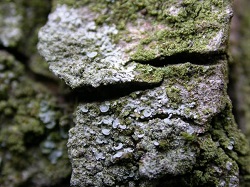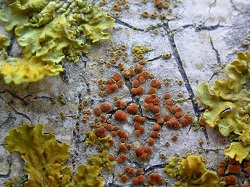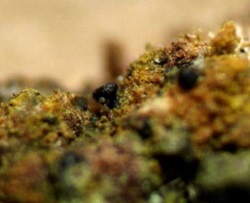Lichens in the Wildspace

 We were very fortunate to have a visit by Mark Powell, Louise Bacon, Catherine Tregaskes and Paula Shipway of the Cambridge Lichen Group. On the 9th April 2017 they carried out a lichen survey on Ely wildspace and the City of Ely Cemetary.
We were very fortunate to have a visit by Mark Powell, Louise Bacon, Catherine Tregaskes and Paula Shipway of the Cambridge Lichen Group. On the 9th April 2017 they carried out a lichen survey on Ely wildspace and the City of Ely Cemetary.
Seventy-seven taxa were recorded from various habitats at Roswell Pits. Of these three are lichenicolous fungi; an under-recorded group of organisms that infect lichens. One of these, Pyrenochaeta xanthoriae was added to the British list in May 2016 The image on the left shows Normandina pulcehella,and on the right, in the centre of the image, are orange patches of Caloplaca pyracea.
 The most notable lichen community occurs on the trunks of old stubby trees on the bank beside Springhead Lane. A particularly notable
example of this community occurs at TL5521.8050 where Bacidia viridifarinosa forms extensive pale green sorediate patches at the bases of
the trunks. B. viridifarinosa is known from just one other site in Cambridgeshire, in Madingley Wood.
The most notable lichen community occurs on the trunks of old stubby trees on the bank beside Springhead Lane. A particularly notable
example of this community occurs at TL5521.8050 where Bacidia viridifarinosa forms extensive pale green sorediate patches at the bases of
the trunks. B. viridifarinosa is known from just one other site in Cambridgeshire, in Madingley Wood.
At the City of Ely cemetery, nothing of particular note was encountered, although some sixty-one taxa were recorded. The old sandstone memorials are thought to retain a toxic legacy from their decades during levels of coal-based atmospheric pollution. The more recent stones provided clean sandstone surfaces after the sulphurous pollution had abated. Thus they supported different communities.
The image on the left is of Lahmia kunzei
The full report and a list of taxa can be download here






